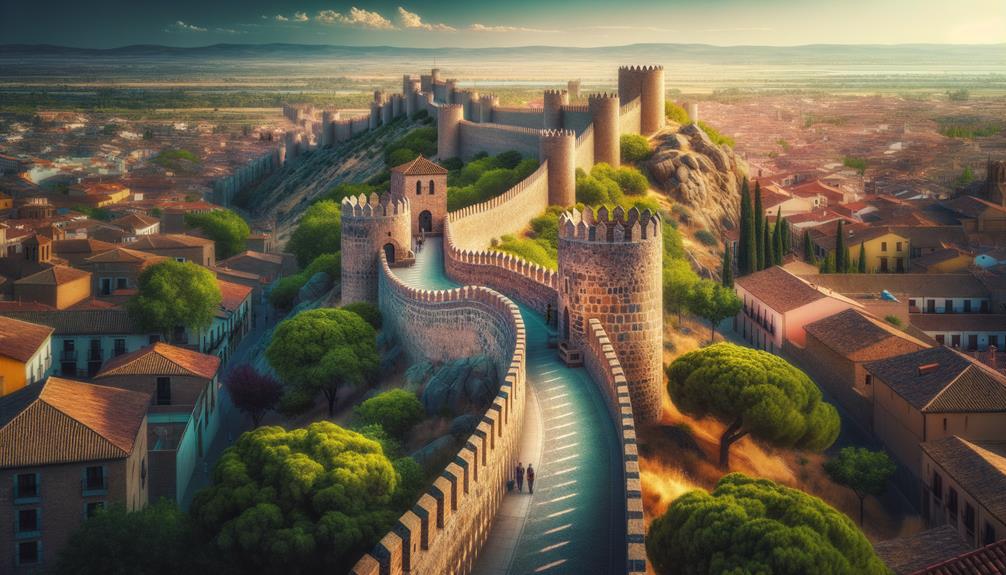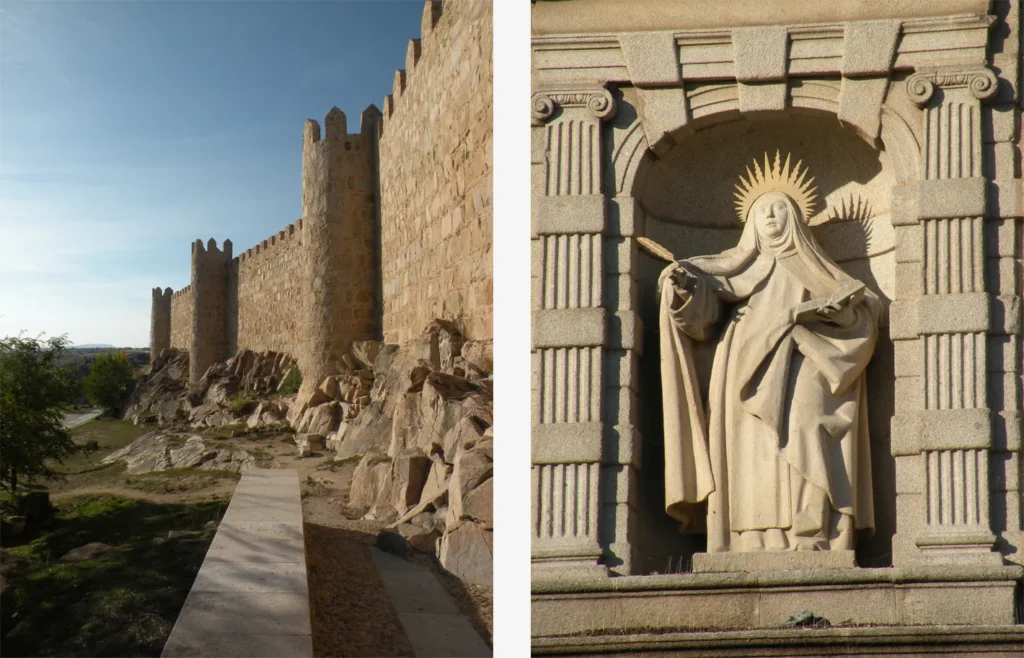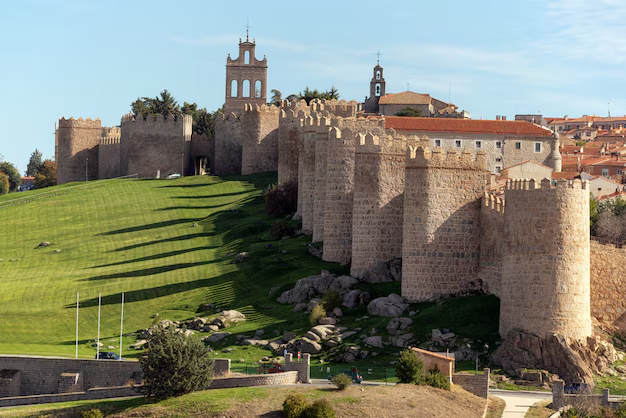Table of Contents
Toggle🏙️ Introduction
Rising from the windswept Castilian plateau, the City Walls of Ávila are more than architectural wonders — they are a dialogue in stone, uniting faith, defense, and art. Built in the 11th century and stretching over 2.5 kilometers, these walls encircle Ávila like a living time capsule, preserving its medieval soul.
Every tower and gate reflects a society where religion and protection were inseparable, where each stone symbolized vigilance and devotion. Few European fortifications remain as intact and monumental — the Walls of Ávila tell stories of knights, mystics, Moorish artisans, and Christian kings. Walking atop them is feeling centuries breathe beneath your feet
🏗️ Origins and Historical Layers
Construction began around 1090 under King Alfonso VI, shortly after the Christian reconquest. Ávila’s walls were not only defensive — they were symbolic, a bastion of faith at the frontier of Islam.
Legend attributes the design to Castrillo, a mix of Christian and Mozarabic builders, giving the walls a unique stylistic fusion: Romanesque precision with subtle Islamic motifs. Over centuries, the walls became both a defense mechanism and a spiritual border — separating sacred interiors (cathedral, monasteries, noble houses) from the secular city outside
🧱 Architectural Details Few Notice
Each of the 88 semi-circular towers varies slightly to adapt to terrain slopes, maintaining optical harmony.
Some stones bear mason marks — crosses, stars, tiny animals etched by 12th-century builders.
The cathedral itself forms part of the wall: its apse doubles as a defensive tower — blending sacred architecture with military engineering, unique in Europe.
💡 Insight: Ávila’s identity is encapsulated in this fusion — devout yet defiant.

🕍 The Sacred City Within
Known as the “City of Saints and Stones,” Ávila’s inner streets host Romanesque churches, Carmelite convents, and noble palaces.
Cathedral of the Saviour (Catedral del Salvador): Gothic-Romanesque blend, featuring sculptures by Vasco de la Zarza.
Saint Teresa of Ávila: Her birthplace, convent, and relics attract global pilgrims. She described the walls as “the embrace of faith around a restless heart
⚔️ Legends and Stories Hidden in the Stones
Local folklore brings the walls to life:
Spirits of builders walk the ramparts on stormy nights.
“Stone of the Moor” near Puerta del Carmen brings luck to travelers who touch it.
Hidden carvings, like hearts or symbols, tell silent stories of medieval lives

🧭 Exploring the Walls Today
Three main walking routes:
Puerta del Alcázar – Puerta del Carmen: Cathedral & old town views.
Puerta del Puente – Puerta del Mariscal: River Adaja & countryside.
Puerta del Puente – Casa de las Carnicerías: Sunset & panoramic vistas.
Practical info:
🎟️ Tickets: ~€5; children under 12 free.
🕰️ Hours: 10 AM – 8 PM (seasonal).
🌇 Best Time: Sunset or night (walls illuminated).
📍 Accessibility: Ramps & elevators added for inclusivity.
Visitor center features digital reconstructions of wall evolution through battles, expansions, and restorations
🗺️ UNESCO World Heritage Status
Designated in 1985, Ávila’s old town and walls are recognized for:
Remarkable conservation
Integrity of a medieval Christian stronghold
The defensive line is 100% traceable from gate to gate, with authenticity preserved — imperfections included.
💫 Symbolism and Meaning
Beyond defense, Ávila’s walls symbolize medieval Spain’s psychology — a civilization balancing fear and faith.
Monumental walls project strength and sanctity.
Architecture as theology: the city is a vision, not just a settlement.
Considered Europe’s best example of sacred fortification
🌍 Modern Ávila: Between Heritage and Life
Today, Ávila harmonizes history and modernity:
Cafés, art galleries, and workshops coexist with monasteries.
Strict architectural guidelines preserve medieval aesthetics.
Restoration projects, stone consolidation, and digital mapping ensure authenticity.
Each summer, the Medieval Market animates the city: artisans, falconers, musicians fill streets in costume — walls as backdrop to chivalry and myth.
🌅 Conclusion
The City Walls of Ávila are more than stone fortifications; they are Spain’s open-air chronicle — a conversation between eternity and time.
To stand on those ancient ramparts is to witness the fusion of architecture, mysticism, and human perseverance.
They embody a paradox: built for defense, yet inviting; made of cold granite, yet full of living warmth.
In a world where many medieval walls fell to ruin, Ávila’s endure — not just because of engineering genius, but because they were born from faith, purpose, and beauty.
As twilight falls and the walls glow against the Castilian sky, one truth becomes clear: Ávila is not a city surrounded by walls — it is a wall that has become a city.
Plan your visit to Ávila and discover the soul of Spain behind its timeless walls



Have you visited this place or tried this dish?
Share your thoughts and experiences in the comments below
Internal Links Suggestions :
WALLS
City Walls – Ávila
Overview: The City Walls of Ávila stretch for 2.5 km with 88 towers and 9 monumental gates. They represent a perfect union of defensive strength and spiritual heritage — with the cathedral itself built into the wall.
Highlights included in the tourist card:
- The walkable City Walls of Ávila.
- Catedral del Salvador – a cathedral integrated into the wall.
- Royal Monastery of Santo Tomás and Monastery of La Encarnación.
- Basilica of San Vicente and the Museum of Ávila.
Local Legends & Hidden Details: Ancient mason marks can still be seen on the stones, and local folklore speaks of the “Stone of the Moor” near Puerta del Carmen — said to bring luck to travelers who touch it before leaving the city.



